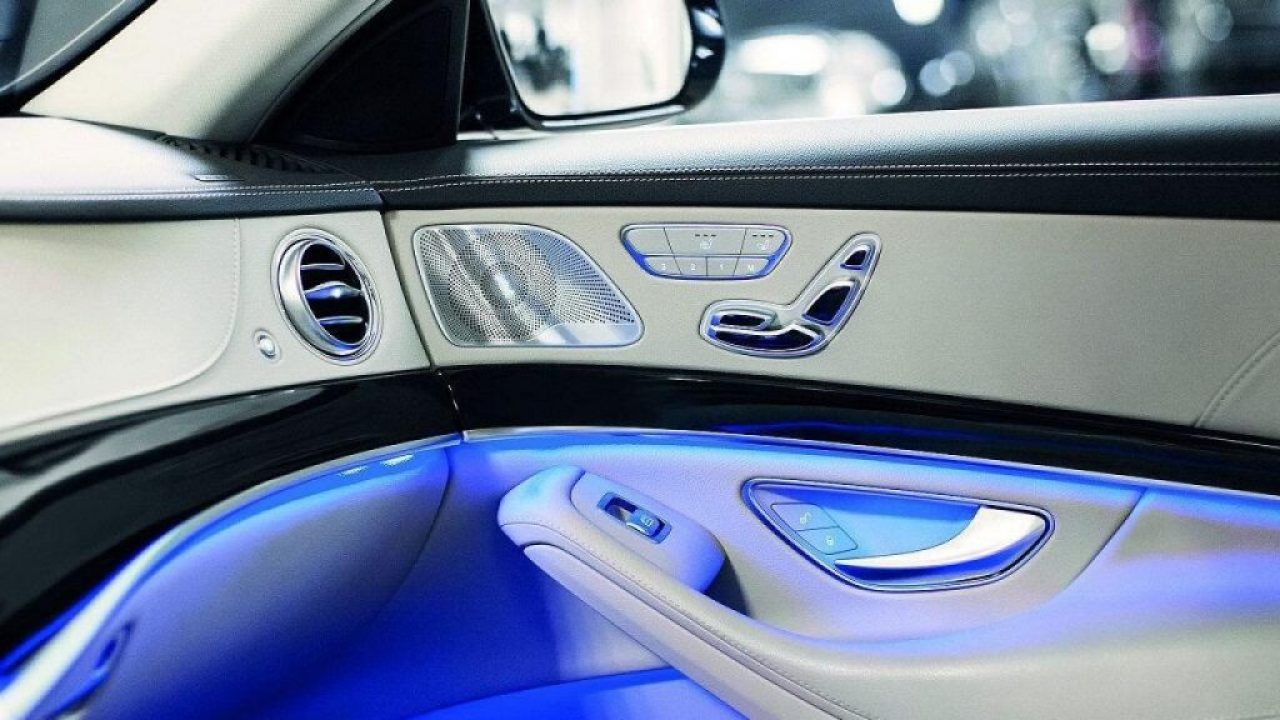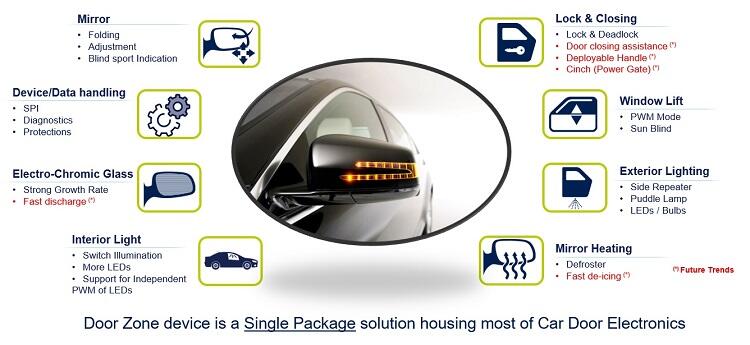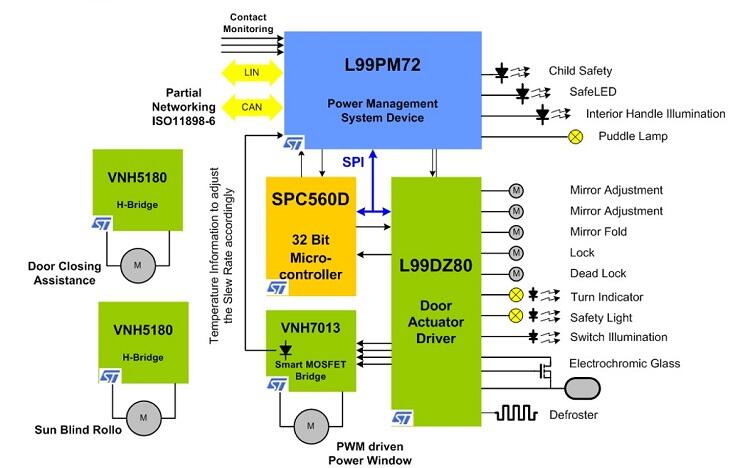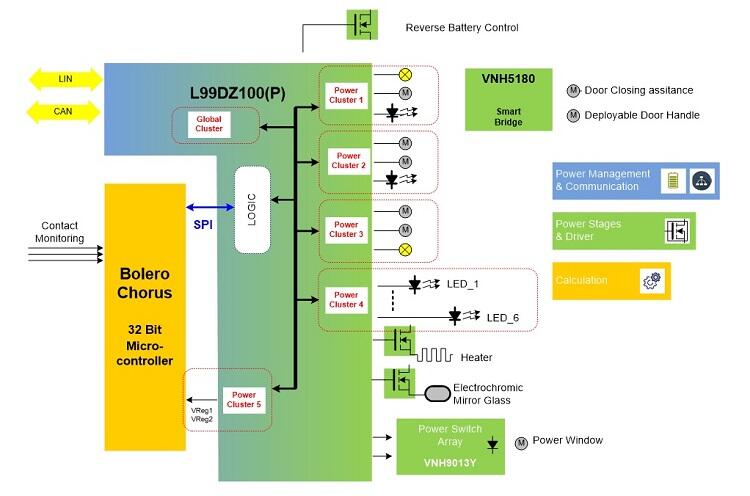Automotive Door Zone System ICs boost Power Efficiency
Article By : G.Torrisi, F. Burkhardt & M. Gaertner, STMicroelectronics

Inorder to boost power efficiency and allow further car electrification, the next generation automotive door zone systems ICs are designed to support the actual known state of the art door electronic applications, and opening up new solutions out of the door to drive loads in an optimized way.
In the last years, electrification has represented one of major trends in the Automotive; Car Electrification is much more than having pure electric vehicles, it is about electricity being increasingly adopted to replace mechanical components/relays by electronics or in some cases allowing new features introduction.
Massive Car Electrification is pushing the trend towards more Autonomous Driving where, in a medium/long term vision, many of the vehicles may be considered as “robo-cabs”. For this new car concepts everything inside the door will be automated based on new driving concepts like smart automatic door opening with anti-collision detection; such a system will detect e.g. pedestrians or cyclists approaching the car and automatically control the door opening to avoid dangerous movement. Also other external obstacles will be detected by future sensors, those will be part of electronics inside the door to make it protected against damages.
Dedicated semiconductor devices are required to facilitate those megatrends: they need to support advanced power management concepts, drive different loads in an electric power range of some mW like LEDs up to powerful DC Motors which can easily reach an instantaneous power dissipation up to 200W. Additionally a high degree of standardized interconnectivity, like CAN and LIN physical layer, among electronic modules in the car.
Carmakers are challenged to determine the correct architecture to deliver those new functionalities at reasonable costs never compromising quality and performances. As costs and complexity continue to increase for both hardware and software development, it is becoming more difficult to keep pace with the performance and functionality demanded by OEMs. Besides, they request deployment of cost-effective solutions that are scalable from low-end cars to very high-end vehicles, with development costs amortized over different platforms and car models.

Fig 1: Definition of a Door Zone device(Source:STMicroelectronics)
A known automotive application that historically has benefited from a scalable approach, is the Door Zone Electronics (fig.1); for this application it is intended a single IC able to drive most of the Door loads (door lock motors, mirror folder and leveling, defroster, window lift and several lighting functions from LEDs to incandescent bulbs). Typically the actuator drivers for automotive door zone applications are characterized by a scalable actuator driving concept, compatible with package and software, to satisfy the multiplicity of door electronics variants.
Over a period of more than 10 years several of such door actuator driver devices have been develop in an evolutional process by adding new features and optimizing packages and semiconductor technologies and IPs to comply with the continuously growing number of electrical loads. In combination with the Door Zone devices (fig.2), another IC is adopted as power management system that provides electronic control units with enhanced system power supply functionality, including various standby modes, as well as communication layer (mainly through LIN and/or HS CAN). Typically a Power Management device embeds two low-drop voltage regulators to supply the system microcontroller and external peripheral loads such as sensors and they are useful to provide enhanced system standby functionality with programmable local and remote wake-up capability.

Fig 2: Advanced Door Electronics Module(Source:STMicroelectronics)
For both of this device families, door actuator drivers as well as power management devices, a dedicated and optimized semiconductor BCD technology (Bipolar, CMOS and DMOS) has been used. The technology nodes have been at 0.7µm for the actuator drivers and at 0.57µm for the power management devices.
With the new Automotive trends, an even larger variety of electrical loads have to be controlled in an efficient and safe manner, minimizing the quiescent current and providing at the same time space and weight reduction with highly integrated solutions that reduce component count and, in the end, dramatically simplify designs.
For example, ST’s advanced BCD8S automotive technology node of 0.16µm provides the key to achieving highly integrated, single-chip solutions (fig.3) that meets power-management, failsafe requirements and door loads actuations. This technology comes with an optimized capability for power and calculation functionality. The much more challenging thermal requirements integrating power management as well as actuator driver on a single chip are satisfied by the higher junction temperature of up to 175°C, which is specified as a standard value for the devices to support the stringent requirements specified by the OEMs.

Fig 2: New BCD8s Auto Device Generation(Source:STMicroelectronics)
Novel STMicroelectronics’ controller chips for car doors – the L99DZ100G / GP for front door applications and the L99DZ120 for the rear doors – help designers to save space while improving reliability and energy efficiency.
Compared to the previous families of door zone ASSPs (Application Specific Standard Products) 2 devices with an outline of 12mm by 12mm (TQFP64) for the door actuator driver and 10mm x 10mm (PowerSSO-36) for the power management devices are replaced by as single device (LQFP64) with the same footprint of the TQFP64. This is very important to support the requested miniaturization of the PCB, to fit to the more stringent space requirements. Beside the shrink of the die size enabled by the new BCD silicon technology this was enabled by new and innovative construction of the package, specifically to handle high current peak and huge power density achieved with miniaturization of the Door System IC.
With the additional advantage of software compatibility between the different members of the family, the building blocks also contribute to a simpler development and to shorten the market introduction time.
Adding more electronics and features to vehicles is a differentiating factor for selling a car, but it also increases the power requirements. As a result, every system’s power consumption, during any and all operating conditions, goes under accurate analysis. This is especially true in pure Electrical car, where wasted power means less mileage range; vehicles with the highest amount of electrical content inevitably have the highest amount of leakage current and, as result, products and/or techniques that reduce quiescent current and standby currents become very important to all carmakers. They often say that “every micro-amp counts” since most ECUs have a 100-µA max standby budget for current consumption.
For that reason, an advanced Power Management with relevant low quiescent modes (standby/sleep, cyclic monitoring, dedicated LDO with low current mode, timers, contact supply) is embedded in the new Door Zone controllers. With the VBAT standby mode, the lowest quiescent current may drop even below 10µA, in in the range of 7-8 µA, compared to the double for the topology with two ICs (Door Zone plus Power Management ICs). In the application, the microcontroller (MCU) isn’t supplied until the regulator is awakened through contact monitoring or through the physical layer (LIN, HS-CAN or HS-CAN supporting selective wake-up).
Novel STMicroelectronics Door Zone controllers do not only represent a combination, in one package, of previous Door Zone actuators plus Power Management ICs. New features have been added to better serve the new automotive trends.
A new IP is implemented in the devices to support an automatic LED duty-cycle compensation, which ensures uniform brightness even when the supply voltage of the ECU fluctuates. This is realized by measuring the supply voltage and correcting the duty cycle applied to the LED driver power stage by a device internal compensation algorithm. To adapt to different loads this feature is programmable to allow the use of different LEDs as well as the serial use of LEDs. This allows to save workload from the external microprocessor and minimize SPI traffic which was up to now the state of the art.
Another new features is the innovative thermal clusters concept that also allows the application to disable individual outputs when an event such as a short circuit occurs; unaffected outputs remain functional in this case.
To comply with requirements for safe operation of the power window, to avoid uncontrolled movement of the window in case of any system error, also a dedicated IP has been developed to enter as safe condition in such case. According to the safety requirements this IP is isolated from the rest of the chip by a deep trench isolation, another valuable feature provided by BCD8s, and even works at loss of battery by a self-biasing approach.
in the future, new requirements will rise up like driving additional powerful DC motors. The modular devices and IPs can be adopted in an incrementally scalable approach to put together in new a configuration. This will also open up new solutions out of the door to drive loads in an optimized way.
Subscribe to Newsletter
Test Qr code text s ss


